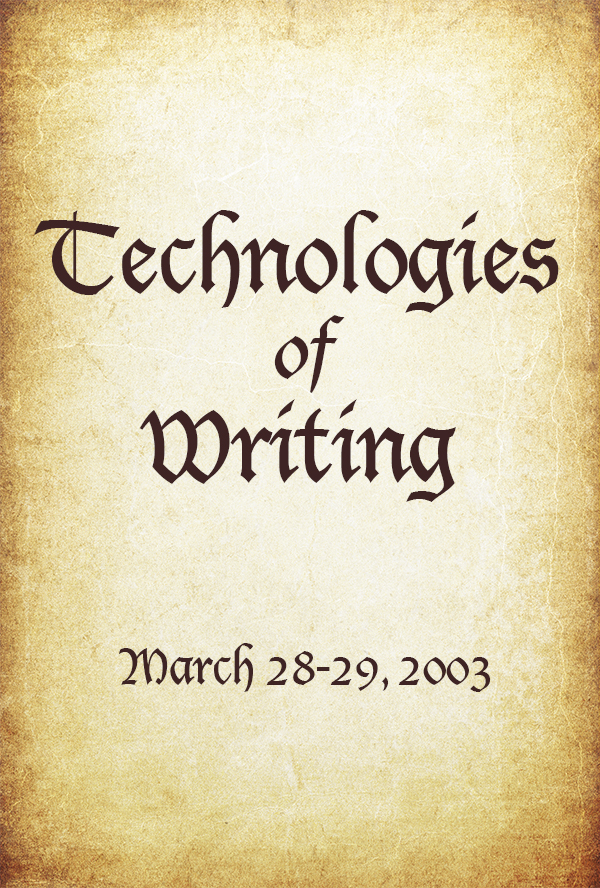Join leading scholars from Europe and the United States, curators of manuscripts and conservators from the
Folger Shakespeare Library, and other experts on the technologies of writing, as they consider the place of writing before and after the coming of print. Explore forms of writing that preceded print culture, in particular wax tablets. Consider the major role that writing continued to play after the invention of printing. There's erasable writing on walls, slates, and tablets. Then there's permanent writing in printed books (e.g., readers'
annotations) and on paintings. And, don't forget those most necessary implements of writing, including styluses, quills, graphite pencils, and paint brushes!
Jacques Derrida wrote in Freud and the Scene of Writing, "A sheet of paper preserves indefinitely but is quickly saturated. A slate, [which can] always be reconstituted by erasing the imprints on it, does not conserve its traces. All the classical writing surfaces offer only one of the two advantages and always present the complemen-tary difficulty."
In the long history of writing surfaces, we would be quite wrong to take an inexhaustible supply of writing surfaces for granted. Most writing surfaces made for endurance have been costly (stone, papyrus, parchment, paper) and have coexisted with cheaper, because reusable, materials (wax tablets, slates, whitewashed walls). Consider, for example, some of the advantages and disadvantages of six major writing surfaces in Western culture—stone, papyrus, parchment, paper, wax, and walls:
Stone is hard to prepare and cut. It would require vast quantities of stone for a long text (say, War and Peace), and it would be enormously time consuming to inscribe such a text. But stone is good for public display, and it has a reasonable resistance to the destructive forces of rain and wind, so it can be used out of doors. (Roman laws; tombstones.)
Papyrus has to be gathered from specific regions (e.g., the Nile, Sicily). It is time consuming to prepare in any quantity and does not do well in wet or humid climates (Philadelphia, for example). But the raw material for
papyrus was relatively accessible.
Parchment requires killing thousands of animals (over 100 for a luxury bible). It requires the large-scale presence of cattle, sheep, goats, or, ideally, aborted calves [vellum = veal]). It is time consuming and expensive to make. Except in the case of young calves, the hair side is considerably rougher than the flesh side. On the other hand, it endures well (much better than paper), and could, until the invention of bible paper, be made considerably finer than paper and without as much see-through. Both papyrus, which was usually written on with soluble ink, and parchment, which was usually written on with permanent ink, were partially erasable, papyrus with a sponge, parchment with a knife.
Paper, until the mid 19th century, required the mass collection of rags (mainly linen rags but increasingly cotton: a sheet of paper from the sheet of a bed). It is time intensive to make, and expensive. As Jim Green of the Library Company of Philadelphia has shown, Benjamin Franklin’s main consideration as a publisher was the quantity of paper, and consequently the investment that he would have to make for any
one book. When his edition of Richardson’s Pamela, which used 17 sheets of paper, failed to sell well, Franklin fell back on the 10 sheets-and-under rule. It's very hard to erase permanent ink, particularly printer's ink, and paper only endures well if it's acid-free. It is subject to bookworms, damp etc.
Wax requires no ink or other substance to write on it. A single instrument both inscribes the text and smooths out the wax to create a new writing surface. Wax tablets are good for notes and rough drafts (of pictures and music, as well as writing), and they save money because the same surface can be repeatedly used. But wax tablets can only be reused at the expense of erasing what went before. The pencil and rubber eraser, used on paper,
perhaps signalled the death knell of the wax tablet.
Walls are easy to write on with a variety of implements, and they can endure for a long time. Both public and private spaces can be used for writing, and the surface can be reused after it has been covered with
whitewash. Juliet Fleming has argued that in Reformation England, walls were more widely used than paper as a writing surface.
Technologies of Writing from Classical Antiquity to Early Modern Europe
March 28, 2003 (Friday) / 2:30 pm—March 29, 2003 (Saturday) / 7:00 pm
Terrace Room, Logan Hall (Friday)
3619 Locust Walk (Saturday)



